PowerShares Shifts To RAFI Index On Junk ETF
Post on: 6 Июнь, 2015 No Comment

PowerShares junk-bond fund switches to RAFI index. Is it the future?
Invesco PowerShares, the Wheaton, Ill.-based fund sponsor known for its “Qs” (Nasdaq: QQQQ) ETF of Nasdaq’s 100-biggest companies, relaunched its junk bond ETF today using an index from Research Affiliates, making it the first-ever fixed-income exchange-traded fund to use a fundamentally weighted benchmark.
While traditional bond indexes weight the largest debtors most heavily, potentially exposing investors to greater risks of default, a fundamentally weighted bond index uses financial fundamentals, including sales, profits, book value and dividends, to determine holdings, leading funds to firms with more manageable levels of debt.
The rechristened PowerShares Fundamental High Yield Corporate Bond Portfolio (NYSEArca: PHB) began trading using the RAFI Corporate Bond Portfolio and carries an expense ratio of 0.50 percent. The fund previously tracked the Wells Fargo High Yield Bond Index.
High yield, or “junk,” bonds were at the center of the meltdown of Drexel Burnham Lambert, the infamous high-flying Wall Street firm that declared bankruptcy in 1990 in the wake of a crash in the junk bond market and allegations of criminal misconduct. Since then, the market for high-yield—and high-risk—corporate debt is popular among those who can stomach the risk, particularly in the current low-interest rate environment in which companies can refinance debt on more favorable terms.
The First Fundamentally Indexed Bond ETF
For PowerShares, this fundamentals-based approach results in a significantly altered product, according to Ed McRedmond, a PowerShares senior executive.
ETF sponsors had to take a “sampling,” rather than a “replication” approach with traditional bond indexes because they often contained hundreds or thousands of securities, many of which were thinly traded.
“The original benchmark indexes weren’t constructed to be used in investment products,” McRedmond said in a telephone interview.
In addition to being built from the ground up as an ETF-friendly index, the RAFI Corporate Bond Portfolio’s fundamental weighting methodology selects higher quality paper.
“It doesn’t have really any exposure to Triple-C,” said McRedmond, referring to the Standard & Poor’s and Moody’s bond rating scale, “while the Wells Fargo index had approximately 20 percent exposure to Triple-C or below.”
The First of Many?
When asked whether there were any more fundamental weighted bond funds in the works at PowerShares, McRedmond hedged, saying: “We don’t have anything out there in registration, but RAFI is a great partner of ours, and our product development people are constantly having discussions around innovative ideas.”
Rob Arnott, the chairman and founder of Newport Beach, Calif.-based Research Affiliates, the provider of RAFI indexes, said in a telephone interview that “it would be unsurprising if [PowerShares’ revamped bond fund] becomes part of a suite of fundamental indexed bond products.”
In particular, Arnott believes emerging market and even sovereign debt lend themselves well to his fundamental indexing approach.
Emerging market debt is appealing to Arnott because of developing countries’ favorable GDP-to-debt ratio. And while developed country sovereign debt initially seemed like the least promising area for a fundamental weighted approach, Arnott said his firm’s back testing revealed “90 basis points annually of added value in sovereign debt” over traditional weighting methodologies. “That blew our socks off.”
Index Swap v. ETF Launch
PowerShares’ rechristening of its Fundamental High Yield Corporate Bond Portfolio (NYSEArca: PHB) is the latest in a series of index swaps for the firm. In June, the fund sponsor changed the underlying indexes in five equity ETFs.
Swapping one index for another is a tempting path for fund sponsors looking to freshen or build their offerings because an extant fund already has a base of assets on which to build. A brand new fund, however must quickly gather assets or face permanent second-class status—or even liquidation.
When asked whether investors should expect more index swaps from PowerShares or other firms in the future, McRedmond acknowledged this was a possibility.
“It’s definitely challenging to launch a new fund from scratch when you have this challenging market, but if you can bring a product to market that’s filling a niche or need, then you may be able to raise assets,” McRedmond said, referring to the prospect of an index change rejuvenating an existing fund.
McRedmond added that the PowerShares Build America Bond Fund (NYSEArca: BAB), a new fund that launched late last year, already has $450 million under management.














